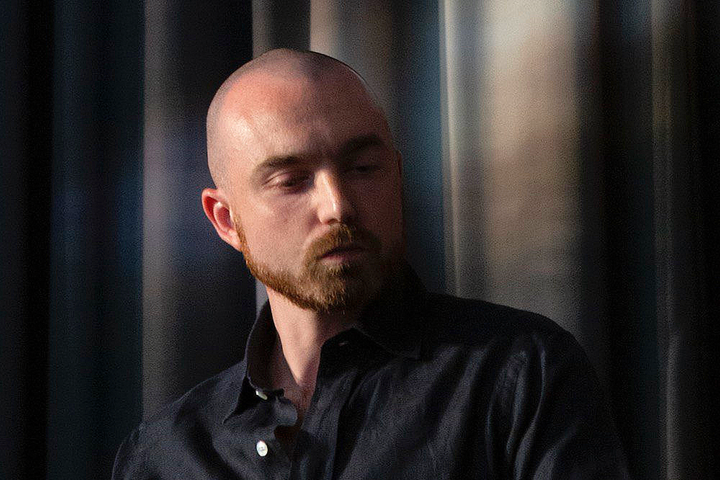Patrick Amadon on Jerry Saltz, censored artwork in Hong Kong, and Web3 Art

Andrea Misiano: What was your journey into digital art?
Patrick Amadon: My background is in art history and I began creating physical artworks after completing university. However, when I discovered social media in 2012, I realized that posting images of oil paintings didn't feel natural on these platforms, and I also lacked the necessary content to keep my social media profiles active. To overcome this, I experimented with glitching the images of my physical works to make them more suitable for digital platforms. This led to the creation of an animated loop of a glitched image, which quickly became more popular than my original physical works.
I found myself on a digital art island where it was difficult to sell my art. I continued to create political and glitch versions of abstract art, however, these two aspects never intersected in my works. I became friends with Jerry Saltz during this period. He advised me to start over, stating that my art was pure zombie formalism. At the time, I was creating glitch versions of images related to global events such as the Syrian civil war and the assassination of Boris Nemtsov. My desire was always to merge my glitch art with social or political commentary, and so I recalibrated my approach to align with this goal. This shift in focus culminated in my Hong Kong piece, which gained a lot of attention in March 2023.
Andrea Misiano: How would you describe your early period of crypto activity?
Patrick Amadon: Initially, my awareness of cryptocurrency began when I heard about the Bitcoin pizza. While I had heard about the Beeple sale in February 2021 and the $68 million price tag, I was unfamiliar with the concept of selling digital art. Intrigued, I immersed myself in the world of cryptocurrency, learning about Metamask and various other aspects. I discovered that the crypto community was a distinct entity with little overlap with my existing audience. After that, I started meeting and connecting with other artists in the field.
When Tezos emerged, I was immediately drawn to it, feeling as if it embodied the independent art scene. I minted a few things on Tezos and dropped them at random times, with a price tag of $100, making it a fun game for people to discover and collect my work.
Sonia Stubblebine: How did Jerry Saltz’s commentary change your art?
Patrick Amadon: That conversation with Jerry helped me realize that while I was creating interesting glitch versions of my abstract pieces, I wasn't necessarily infusing them with meaning. It was at that point that I decided to merge these two tracks of my artistic practice and start creating pieces that combined both my love for abstract art and my desire to address political issues.
This was a bit of a challenge at first, but it ultimately felt more natural and purposeful to me. I was fortunate to have a large following on social media, which allowed me to share my work with thousands of people and receive lots of feedback.
Sonia Stubblebine: What was it about politics that actually struck you and why is it important for you as an artist today?
Patrick Amadon: I remember witnessing the early stages of the Syrian civil war and feeling a sense of helplessness as innocent civilians were being brutalized by the Assad regime. However, the conflict did not seem to resonate with Western audiences, as there was no oil or any political cause that would capture their attention. This was also true for other conflicts such as one in Sudan. Despite feeling the urge to create art that shed light on these issues, the images and stories coming from these areas were often too horrific to share in their unedited form.
The rise of social media during the Arab Spring allowed the public to become more aware of these conflicts through unsanitized images and experiences captured on phones. However, these images were often too graphic for most people to look at. This is where glitch art came in. By glitching these images, it took away some of the reality of the situation, but it also made it easier to share them without being too overwhelming. I felt that this method made the images more accessible and relatable to people, which was my main goal.
In short, whenever I came across something that I felt was worth sharing, I would use my art to shed light on the issue by glitching the images and presenting them in a way that was more palatable to the public.
Sonia Stubblebine: How would you describe the current state of the digital art market?
Patrick Amadon: The emergence of this new market brought about a new group of buyers who are less familiar with the art world and more focused on the financial incentives associated with digital art. As a result, there has been a significant increase in the number of new collectors, many of whom are not necessarily familiar with the artistic conventions of contemporary art.
While this influx of new participants has contributed to the growth of the digital art market, there is a need for more guidance and context to help ensure that the space is more grounded in the principles of contemporary art. Today there are limited opportunities for writers and curators to earn a living in this space, which poses a challenge to the creation of a more robust and well-informed community of digital art enthusiasts.
In conclusion, the digital art market is a relatively young and rapidly evolving space that requires a more nuanced and comprehensive understanding of the various forces at play. While there is great potential for this market to grow and thrive, it will require the involvement of a diverse set of actors, including artists, collectors, writers, curators, and educators, to help shape its future.
Sonia Stubblebine: What would you like to see more of in the digital art market?
Patrick Amadon: There is a need for more writers and curators to enter the space and provide a critical lens to help guide collectors and creators toward meaningful and impactful digital art. By considering factors beyond financial gains, such as interesting commentary and artistic value, collectors can better understand the potential longevity and relevance of a piece of digital art. It is important for the digital art community to develop a more robust critical framework and engage with contemporary art practices to help digital art ascend in the art world. The digital art market is still relatively young, and there is a need for more critical engagement to help shape its trajectory.
Andrea Misiano: What needs to change in the digital art market for it to become more open?
Patrick Amadon: I think we need more focus on creating work that is relevant outside of the digital art sphere. This can be achieved by creating work that affects the physical world in a traditional sense, and museums and institutions could play a role in promoting this kind of art to a wider audience.
Andrea Misiano: What is your take on the future of Web3 art?
Patrick Amadon: There are now many more opportunities for digital art to be consumed than ever before. We are constantly surrounded by screens and immersed in digital identity and existence. Digital art has the potential to infiltrate people's experiences in ways that traditional art cannot. It's only a matter of time before digital art becomes one of the most impactful mediums for art. This change in perception will likely evolve over the next 10 to 20 years, as younger generations who grew up with computers become the tastemakers. The majority of the art world is currently controlled by tastemakers who are 60 to 80 years old, but the 40 and younger group will eventually take over. As they grow up in a digital world, their tastes will be much different than those of the current tastemakers. This shift toward digital art will be gradual but significant. In 10 to 20 years, digital art will be what abstract art was 50 years ago.



